voice through play - and enable others to learn about them. Class
teacher Jay Ramsey shares his setting's experience

At St Werburgh's Park Nursery School, Bristol, we view 'Story Square' as a powerful method of storytelling, with the potential to give every child a voice and to enable children to listen to each other.
Story Square - or Helicopter Stories, or Story Telling and Story Acting - is based on the pioneering and inspirational work of Vivian Gussin Paley. Very simply, it involves listening to children and writing down their stories in their own words, followed by facilitating the acting out of the stories with the children.
Paley developed the approach over many years of intense observation, practice, reflection and structural adjustment. What she has achieved stands as a beacon of good practice and an invitation for us all to allow children to benefit from her profound insights.
Thankfully, we can build on her achievements without having to repeat the years of groundbreaking work, and recently our setting was awarded the Helicopter Stories Centre of Excellence award in recognition of our work. As Paley reminds us, 'play is story in action, storytelling is play put into narrative form'.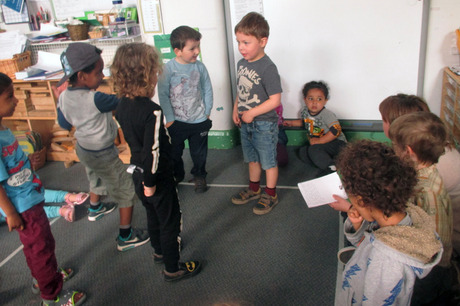
ENTERING THE WORLD OF PLAY
Story Square taps into this world of play, where children are alive with excitement, highly motivated and frequently pushing themselves beyond their abilities.
We all know the many benefits of play and how it is the fastest way for children to learn, yet the pressure of assessment, attainment and early learning goals often means that play, with its wild, unpredictable, individualistic, sometimes unfathomable and often exclusive nature, is pushed aside in favour of more structured learning with predicted outcomes that are easier to assess.
Story Square, however, provides a structure for play within which recording is an integral part, enabling continual reflection for the child and easy assessment of progress for the adult. It not only encourages practitioners to observe play but it also enables them to participate in play and, while doing so, to facilitate fair play.
As for the children, this method of storytelling provides safety so everyone feels confident and secure enough to participate; the playing field is levelled so it is not just the socially dominant or articulate children who benefit from the enhanced learning potential that occurs while in a state of play.
A sense of social fairness and community development lies at the heart of Story Square and needs to be foremost in the minds of the adults. Children recognise and respond to it; it allows them to understand each other and tolerate and develop empathy for each other's situations. It is actively inclusive ensuring that all children regardless of language, ability or educational needs belong within the community of their class.
Calling on children to allow her to observe their play, Paley writes, 'Let me study your play and figure out how play helps you solve your problems. Play contains your questions and I must know what questions you are asking before mine will be helpful.' And in explaining the adult role in their storytelling, she writes, 'Put your play into formal narratives, and I will help you and your classmates listen to one another. In this way you will build a literature of images and themes, of beginnings and endings, of references and allusions. You must invent your own literature if you are to connect your ideas to the ideas of others.'
STORY SQUARE STEP BY STEP
Collecting stories
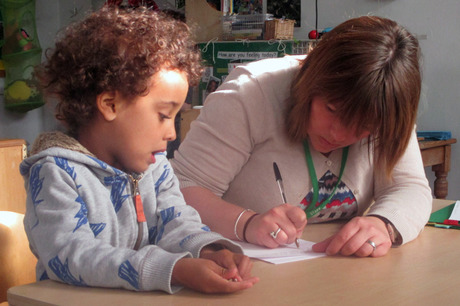
I relish the story-collecting part of the process where you give the child your undivided attention, where they are the expert and you have the opportunity to really hear what they are saying. At this stage, you should:
- write down their story in their own language
- repeat each word as you write it to let them know you have heard them correctly, and
- provide them with the opportunity to make adjustments if you have made a mistake or they change their mind.
- Speaking their words as you write them also emphasises the link between the spoken and written word.
Many children become fascinated with watching you write - they will ask you what you have just written, they notice the spaces between words, they notice letter shapes within words and ask what sounds they are. They point to earlier words and ask, 'What is that one? And that one? And that one?', delighted each time their own words from their own story come back to them. They enjoy hearing their own words and they enjoy being in charge.
Putting the child in the position of the expert, where they have control, is a deliberate action on our part. It empowers the child, increasing their feelings of confidence and self-esteem, encouraging them to express themselves fully and freely, and ensuring that we witness (and record) the very best they have to offer.
Uninhibited by fear of failure, they challenge themselves to articulate and express the highly charged images and emotions they have inside. Working at the top edge of their ability, they risk great vulnerability for the joy of connection and feeling understood. This is a fragile state, and we must never forget how privileged we are to witness it and consciously try to maintain it.
Most children will quickly withdraw and clam up if they feel criticised or that they have done something wrong, might make a mistake, or might look stupid. So, in your quest to understand what the child is telling you, you should:
- keep questions gentle and open
- avoid correcting grammar, and
- if the children are speaking too fast for you to write, instead of telling them to stop or slow down, explain that you cannot write very fast, that their story is really important, and please can they help you get it right by talking more slowly. The 'I am not as fast as you, please wait for me' message is much easier for them to accept without thinking they are in the wrong, so of course they will be generous and wait for this slow person to catch up.
Keep the stories short (no longer than one side of A5) to ensure you can act out as many different children's stories as possible on the same day. When the children have finished telling you their story:
- read it back to them to give them the chance to edit it
- underline each character in the story where they first appear and circle which character (if any) the author would like to play.
This is also a good time to clarify any remaining confusion you may have about the story. Paley notes, 'I question any aspect of the story I might misinterpret - any words, phrase, sound effect, character, or action that does not make sense to me without further explanation. The child knows the story will soon be acted out and the actions will need clear directions. The story must make sense to everyone: actors, audience, and narrator.'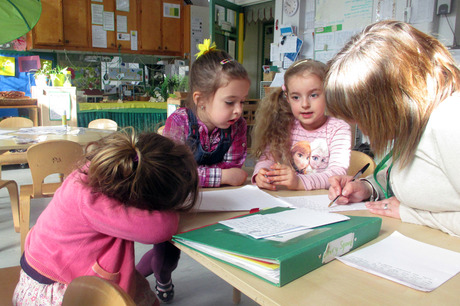
Acting the stories
- Act out all the stories on the same day they are told to you.
- Start by marking out a square on the ground. This can be done with chalk on the playground, rope on the grass, or masking tape inside. The size depends on the space available and the number of children. It needs to be large enough for everyone to sit around the outside facing in.
- Ask the author to come and sit next to you and introduce the story as theirs.
- Read out the story to just beyond the first character.
- If the character is circled, invite the author onto the stage to play the part.
- If it is not the author's character, invite the next child along to be the character.
- If the child is keen to take part but just stands there unsure what to do, then encourage movement gesture and expression with open prompts - 'Can you show us/can we see/hear what/how a horse might look/sound/move/feel like?'
- Give specific praise for what you see and hear. Look out for very small finger or hand movements, or maybe just be a slight change in expression or posture, all of which are great starts and worthy of recognition and praise.
- If a child is still unsure of what to do, you may like to ask the author if they can show us how the horse might move, or you may like to open it up to the group - 'Can you all move like horses?'
- Try to sit on your hands and avoid demonstrating actions yourself, as it can lead to the children thinking there is a right way to be a horse and so they copy you rather than express themselves.
- Bring the group back to the story and repeat what you have already read, allowing time for the action.
- Continue reading until you reach the next character, invite the next child into the square and repeat the process, gradually working your way around the square as the story progresses.
- If a child prefers to watch rather than act that is fine - the role of the audience is equally important - so just ask the next child along.
- When, over the course of a story or two, all the children around the square have had the chance to act and you get back to the child who preferred to watch the last time, give them another opportunity this time around - you never know when they might join in, or which story or character might capture their imagination and compel them to act.
The author gets to choose which character they play in their own story, but in the interests of social fairness they don't get to choose who plays the other characters. Similarly, children around the square only get to accept or decline the character you offer them (which is determined by what stage the story is at and where they are sat around the square), they don't get to choose which role they play in other people's stories. Children accept these rules easily as it takes the pressure off them to compete for favourite characters and allows the stories to progress smoothly.
HOW OFTEN?
Engaging in Story Square every day is not too much, and you should do it at least once a week. Nothing interests children as much as the other children in their class and this allows all of them access to each other's worlds.
The more frequently you do it, the more these worlds merge - characters and bits of stories move from child to child, story to story, story to play and a class culture and community emerges where children, practitioners and parents alike reference characters, plots and meanings, behaviours are contextualised, motives understood, learning and belonging enhanced. And remember, as Paley reminds us, 'discovering and using the essence of any part of ourselves is the most euphoric experience of all'.
Jay Ramsey is class teacher at St Werburgh's Park Nursery School
VIVIAN GUSSIN PALEY
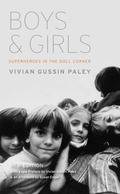 Vivian Gussin Paley has exerted a huge influence on early years practice, both nationally and internationally, due largely to her sensitive observations of young children's fantasy play and her pioneering work on storytelling.
Vivian Gussin Paley has exerted a huge influence on early years practice, both nationally and internationally, due largely to her sensitive observations of young children's fantasy play and her pioneering work on storytelling.
Many of her influential books show how fantasy play provides children with an ever-dependable pathway to knowledge and certainty in the face of life's risks and dangers. Titles include:
- Boys and Girls: superheroes in the doll corner - this groundbreaking book, first published in 1984, was last year reissued in a new edition.
- Bad Guys Don't Have Birthdays: fantasy play at four (1988)
- The Boy Who Would be a Helicopter: uses of storytelling in the classroom (1991)
- Kwanzaa and Me: a teacher's story (1995)
- The Girl with the Brown Crayon: how children use stories to shape their lives (1997)
- The Kindness of Children (1999)
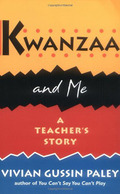 - In Mrs Tully's Room: a childcare portrait (2001)
- In Mrs Tully's Room: a childcare portrait (2001)
- A Child's Work: the importance of fantasy play (2004)
- The Boy on the Beach: building community through play (2010)
Find out more
For details on the life and work, of Vivian Gussin Paley, see Nursery World's early years pioneers series at www.nurseryworld.co.uk/early-years-pioneers
Other articles exploring Paley's influence on practice include:
- 'All about... superhero play'
- 'All about... children's storymaking'
- 'Let's explore... bad guys'
- A short history of... early education'
MORE INFORMATION
All Vivian Gussin Paley quotes are taken from The Boy Who Would be a Helicopter: the uses of storytelling in the classroom (Harvard University Press)
For videos, information and training, visit: www.makebelievearts.co.uk/helicopter. At the bottom of the page, you'll also find research findings about the technique
St Werburgh's Story Square video, www.stwerburghs.com/about/video
The internet is rich with inspirational articles and videos about Vivian Gussin Paley and this work. Here are a few to get you started: www.youtube.com/watch?v=wWxYRkmHNXM; www.youtube.com/watch?v=AniBUTmcM3M; http://vimeo.com/2837273.









